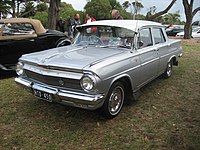Holden EJ
| Holden EJ | |
|---|---|
Holden Special Sedan | |
| Overview | |
| Manufacturer | Holden (General Motors) |
| Also called | Holden Standard Holden Special Holden Premier Holden Utility Holden Panel Van |
| Production | Sedan & Station Sedan: July 1962 – August 1963 Utility & Panel Van: January–August 1963 |
| Designer | Alf Payze, Stan Parker |
| Body and chassis | |
| Class | Mid-size |
| Body style | 4-door sedan 5-door station wagon 2-door coupé utility 2-door panel van |
| Layout | FR layout |
| Related | Opel Kapitän[1] |
| Powertrain | |
| Engine | 2.3L GMH '138' I6 |
| Transmission | 3-speed manual 3-speed "Hydra-Matic" automatic |
| Dimensions | |
| Wheelbase | 105.0 inches (2667 mm) |
| Length | 176.9 inches (4493 mm) |
| Width | 68.0 inches (1727 mm) |
| Height | 58.0 inches (1473 mm) |
| Curb weight | Standard Sedan: 2492lb (1130 kg) |
| Chronology | |
| Predecessor | Holden EK |
| Successor | Holden EH |
The Holden EJ is a motor vehicle produced by General Motors-Holden's in Australia from 1962 to 1963.[1] Introduced in July 1962,[2] the EJ replaced the Holden EK series.[1]
Overview
[edit]The styling of the EJ was a radical departure from that of the EK, with a lower roofline, a flatter boot and an absence of fins.[1] Improvements were made to the brakes, front suspension and the Hydra-matic automatic transmission.[1]
A new luxury model, the Holden Premier, made its debut in the EJ series, and featured leather interior, bucket seats, metallic paint, a heater/demister with centre console, and arm rests on all four doors.[1] It was fitted with Hydra-matic 3-speed automatic transmission as standard equipment,[1] which was optional on other EJ series models.[3][4]
Model range
[edit]On introduction, the EJ range consisted of four-door sedans in three trim levels and five-door station wagons in two trim levels.[3] A two-door coupe utility and a two-door panel van were added to the range in January 1963.[2] The seven models were marketed as follows:
- Holden Standard Sedan[3]
- Holden Special Sedan[3]
- Holden Premier Sedan[3]
- Holden Standard Station Sedan[3]
- Holden Special Station Sedan[3]
- Holden Utility[4]
- Holden Panel Van[4]
-
Holden Special Sedan
-
Holden Special Station Sedan
-
Holden Premier Sedan
-
Holden Premier Sedan
-
Holden Utility
-
Holden Utility
-
Holden Panel Van
Engines
[edit]All EJ models were powered by a 138-cubic-inch (2,262 cc) inline six-cylinder engine, producing 75 bhp (56 kW).[2] Since the introduction of the original Holden 48-215 model in 1948, Holdens had been fitted with what was commonly known as the grey motor. The EJ was the last Holden to be equipped with that engine.The last Grey motor was made on Friday the 2nd of August 1963.
Production and replacement
[edit]After a production run of 154,811 vehicles,[2] the EJ was replaced by the Holden EH series[5] in August 1963.[6] The 1,000,000th Holden, an EJ Premier, was produced on 26 October 1962.[1]
The EJ was also assembled in New Zealand by GMNZ,[7] and was marketed in South Africa as well.[8]
References
[edit]- ^ a b c d e f g h Holden EJ at www.uniquecarsandparts.com.au
- ^ a b c d Holden EJ Technical Specifications Retrieved from www.uniquecarsandparts.com.au on 24 March 2010
- ^ a b c d e f g Holden EJ sales brochure
- ^ a b c Holden EJ sales brochure 130M of January 1963
- ^ Holden EH Retrieved from www.uniquecarsandparts.com.au on 24 March 2010
- ^ Holden EH Technical Specifications Retrieved from www.uniquecarsandparts.com.au on 24 March 2010
- ^ Webster, Mark (2002), Assembly: New Zealand Car Production 1921-98, Birkenhead, Auckland, New Zealand: Reed, p. 80c, ISBN 0-7900-0846-7
- ^ Wright, Cedric, ed. (August 1968). "A car owners' report: Holden (1960–66)". CAR (South Africa). Vol. 12, no. 7. Cape Town, South Africa: Central News Agency Ltd. p. 28.
Further reading
[edit]- Norm Darwin, 100 Years of GM in Australia, 2002
- Norm Darwin, The history of Holden since 1917, 1983
- AC Bushby, The Holden collection: a nostalgic look at the first 30 years of Holden cars in Australia, 1988
External links
[edit]- A Brief History of the EJ Holden Includes scans of Holden EJ sales brochures and advertisements.





